Crowned Earthstar
(Geastrum coronatum)
NMV Ga 211030
Crowned Earthstar is first of all a dunal coast earthstar.
That means this earthstar is in urban area dependant on sand supplemetion
from the Northsea or the former Zuiderzee, but there is also a dependance of typical trees and shrubs for the right soil conditions
Inside the urban district habitats are restricted to road-sides, harbors, railway stations and so on.
There are places enough that meet this conditions. Still the number of observations is small.
And that might be caused by the growing season: in late autumn and mid winter few people are hunting for earthstars in the urban area.
|
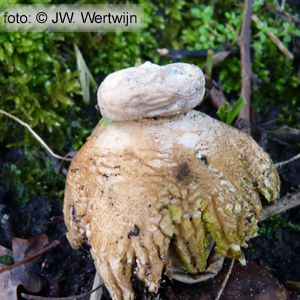
Photo left:
Crowned Earthstar Meijendel |
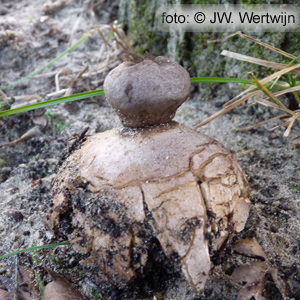
Photo right:
Crowned Earthstar Meijendel |
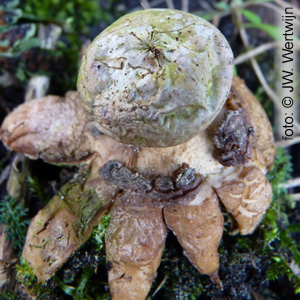
Photo's:
Crowned Earthstar, november 30, 2011 |
How to exclude mistakability:
- Describe the mouth-zone (growing-phase dependant)
- Is a stem visible (growing-phase dependant)
- Look at the bottom of the earthstar:
- Is it fixed in the ground (encrusted debris)?
- Is there a scar in the middel at the bottom of the star-rays?
- Is color changing at injuring
- If this is not helpful: dry the earthstar, and see what changes during the dry-process: stem, apophyse, collar, mouth-zone?
|
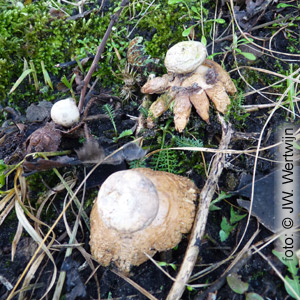
Habitat:
Under Hawthorn
at the bottom of a vegetation poor slope |
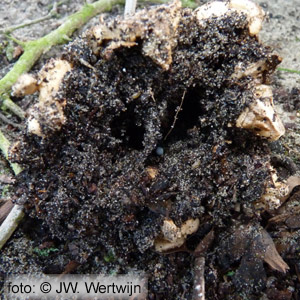
Photo:
Crowned Earthstar,
encrusted debris |
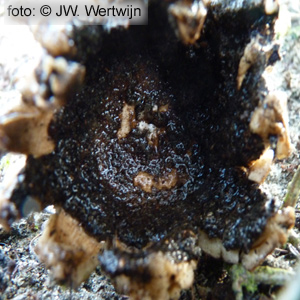
Photo:
After breaking out debris,
and cleaning with water |
Field-Marks: See: Anatomy Genus Geastrum
- Species size: average big
- Stem (under balloon): broad, short, 1-6 mm long, 3-6 mm thick
- Apophyse: rounded bag-shape
- Stem color: dark
- Balloon surface young: fine cristalline or floury
- Balloon surface old: baldy
- Balloon color young: light-grey to creme-brown
- Balloon color older: dark-grey to black
- Balloon mouth-zone: fibrillose, flat to conical,
- Balloon mouth-zone: small or no court, unclear or no ring-furrow
- Star-rays number: 7-12
- Star-rays-thickness: young till 5 mm, afterwards bursting and peeling skin
- Star-rays-color young: light beige to light-brown
- Star-rays-color older: light grey-white to grey-brown
- Star-rays: non-hygroscopic, old: ray-tips sometimes curling once up or down
- Star-rays young: encrusted debris
- Star-rays very old: bald and grey
- Star-rays very old: no scar, sometimes a baldy pitch
|
Habitat:
Tree layer: high woods with Ash, Elm, Maple and/or Coomon Oak, older Hawthorn woods
Spices layer: no spices or very tiny glechoma and urtica on almost naked soil.
Soil: thin fast humous forming layer on sand
|
|
Wood species:
Deciduous wood (Ash, Elm, Maple, Oak; Hawthorn, Black Elder, Common Spindle Tree)
|
|
Regional:
Urban Area: Amsterdamse bos, Oeverlanden.
Pleistocene area: Stichtse brug (A27).
Northsea Dunal Area: From south to north (Bergen) in calcareous dunes.
|
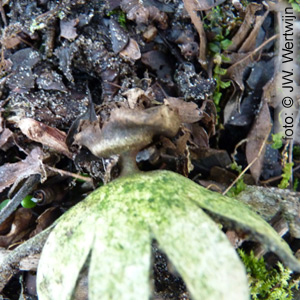 |
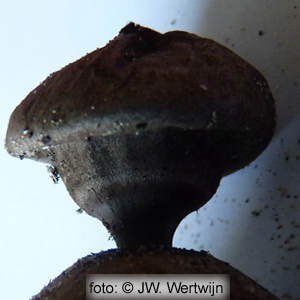 |
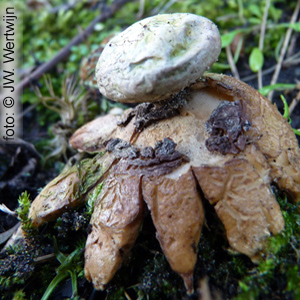 |
Crowned Earthstar (old) |
Crowned Earthstar (dried herbarium ex.) |
Meijendel, January 7 2012 |
Mistakability young, in moisty circumstances with:
- (Robust) Curling Earthstar (Geastrum pseudolimbatum)
- Tiny Earthstar (Geastrum minimum)
Mistakability because of growing troubles like suddenly dry weather:
|
Literature:
Chrispijn, R. ed. (1999), Champignons in de Jordaan (De paddenstoelen van Amsterdam), Schuyt en Co, 162-163.
Gerhardt (2006), De grote Paddenstoelen Gids (voor onderweg), Tirion Natuur, 616.
Hansen, L & K. Knudsen (1997), Nordic Macromycetes, Kopenhagen, Vol 3, 345.
Jalink (1995), De aardsterren van Nederland en België, Coolia 38 supplement, 59-60.
Pegler, e.o. (1995), British puffballs, earthstars and stinkhorns, an account of the british gasteroid fungi, Royal Botanic Gardens, kew, 1995, 255 pp.
Vermeulen (1999), Paddestoelen, Schimmels en Slijmzwammen van Vlaanderen, Wielewaal, Turnhout, 541.
www.mycobank.com
|
Top
|